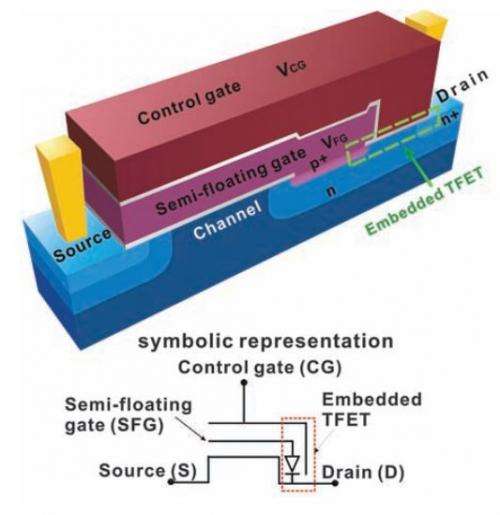August 9, 2013 report
Researchers speed up transistors by embedding tunneling field-effect transistor

(Phys.org) —Researchers at Fudan University in China have discovered a way to speed up traditional computer transistors by embedding tunneling field-effect transistors (TFETs) in them. In their paper published in the journal Science, the team describes how embedding TFETs in such transistors allows for them to be run with less power, which in turn causes them to run faster.
Most modern computers are run with either metal-oxide-semiconductor field-effect transistors (MOSFETs) or a variation of them called floating-gate (FG) MOSFETs. Such transistors are now reaching their physical limit as far as how thin they can be—just a few atoms thick. For that reason, researchers have been looking for other ways to get more bang for their buck. In this new effort, the researchers turned to TFETs, which use quantum tunneling to move electrons through very thin material.
TFETs have traditionally been used in very low power devices. In this endeavor, they researchers created a TFET that could be used to control the electrodes that monitor the flow of electricity into a MOSFET—in this case, the floating-gate variety (it has an additional electrode gate that allows a charge to be retained). The idea is that if the gate could be made to open and close faster, the transistor as a whole would operate faster. Current chips require a build-up of charge before the gate can be opened or closed—which requires time. TFETs, because they require less power, don't take as long to do their work, thus embedding one in a floating gate-MOSFET would alleviate the necessity of power buildup prior to gate changes, allowing for quicker opening and closing. That's exactly what the team in China has done. Testing thus far has shown MOSFETs with embedded TFETs have improved transistor speeds as well as reduced power requirements.
The team reports that because of the way their TFETs are constructed, embedding them in current model MOSFETs should not require reconfiguration or the use of any new materials. This means that the new TFET technology could be put into use almost immediately, bumping up the speed of computers and hand held devices while lessening the amount of energy used, resulting in longer battery life.
More information: A Semi-Floating Gate Transistor for Low-Voltage Ultrafast Memory and Sensing Operation, Science 9 August 2013: Vol. 341 no. 6146 pp. 640-643 DOI: 10.1126/science.1240961
ABSTRACT
As the semiconductor devices of integrated circuits approach the physical limitations of scaling, alternative transistor and memory designs are needed to achieve improvements in speed, density, and power consumption. We report on a transistor that uses an embedded tunneling field-effect transistor for charging and discharging the semi-floating gate. This transistor operates at low voltages (?2.0 volts), with a large threshold voltage window of 3.1 volts, and can achieve ultra–high-speed writing operations (on time scales of ~1 nanosecond). A linear dependence of drain current on light intensity was observed when the transistor was exposed to light, so possible applications include image sensing with high density and performance.
Journal information: Science
© 2013 Phys.org





















